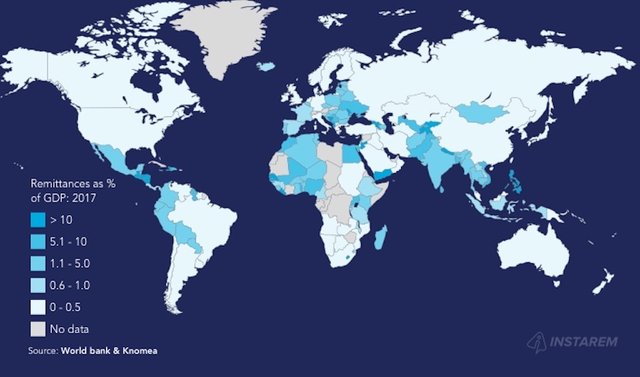
Indian migrants sent US$5.71bn in remittances to other countries in 2017
India is a multicultural country, which has many migrants sending money back to their family and friends overseas. Globally, these remittances totalled US$613bn in 2017, according to the World Bank.
InstaReM, a leading digital cross-border money transfer company, has created an animation to visualise the World Bank’s latest remittance estimates to show where India stands.
Bangladesh was the top receiver of remittances from India, with US $4,033 million being sent in 2017. Followed by Nepal, Sri Lanka, China and France, respectively.
“These international money transfers by migrants are, for many, the only source of income for families globally which help them to get basic necessities, thus elevating overall quality of life,” says Prajit Nanu, co-founder and CEO at InstaReM. “Migrants typically transfer a substantial part of their earnings to their home countries, contributing to their overall income.”
Conversely, United Arab Emirates was the largest sender of remittances India, with US$13823 million being received from there. The US, Saudi Arabia, Kuwait and Qatar were the next biggest senders.
“These days it is not rare to see people from developed nations migrating to other countries as part of their professional careers,” Prajit adds.
These estimates are made by the World Bank using data from formal channels such as banks and other businesses that transfer money. “With so many Indians sending remittances we have formulated a few cost-saving tips when one is transferring money,” says Prajit.

Shop around
It’s easy to stick with the same channel you’ve always used when transferring money, but this could come at a cost if you don’t do your homework. Check online and recent news reports for the latest on each company, including deals and offers. Speak to friends and family, as there’s nothing more valuable than a recommendation. Check online review sites such as TrustPilot as well.
Get a market watching service
This tip can save you from taking unnecessary losses caused by currency exchange rate fluctuations. Most of us don’t have time to keep track of currency markets or know what events can threaten our money’s power. That’s where a payments company market watching service can help, as they can send you regular updates on what direction your currencies are moving, based on live currency rates.
Transfer money online
Online transfers are generally cheaper and faster than going into your local bank branch or doing it over the phone. Plus, paying online gives customers on-the-spot notifications for their transactions and has higher physical security as you are not walking around with a lot of cash.
Set time aside for the transfer
If you are willing to wait for a few days to be transferred instead of instant transfers, this can help you save money on express transfer rates. Usually transferring money on Mondays or Tuesdays can get the transaction through faster than on any other day, because it can take 2-3 working days to process the request.
Keep an eye out for hidden charges
You are usually charged a send fee, a receiver’s fee and margin on the exchange rate if you send through your bank. Be wise and don't get carried away by the claims of fee-free transfers. If your money transfer operator is promising you zero-fee money transfers, they will try to recover their costs (and profits) somewhere else. It would help to compare exchange rates offered by your fee-free money transfer provider with the ones available on Reuters or Google. However, when sending with InstaReM, for example, there calculator breaks down the fees that you will be charged, so you are in the know beforehand.
To find out more about other country remittance inflows and outflows, as well as how this breakdowns as a % of GDP (gross domestic product), visit the InstaReM blog here: https://www.instarem.com/blog/remittances-how-much-money-do-migrants-send-home/
Posted from my blog with SteemPress : http://www.theindiansun.com.au/2018/08/13/planning-money-transfer-keep-eye-hidden-charges/